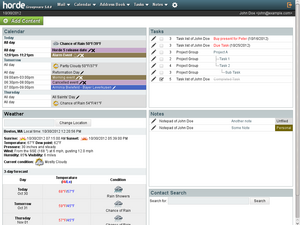 | |
 Portal screen of Horde Groupware (5.0) | |
| Developer(s) | The Horde Core Team |
|---|---|
| Stable release | 5.2.23[1]
/ 14 June 2020 |
| Repository | |
| Written in | PHP |
| Operating system | Cross-platform |
| Available in | English and many others (multilingual)[2] |
| Type | Web application framework |
| License | GNU Lesser General Public License |
| Website | www |
Horde is a free web-based groupware. The components of this groupware rest on the Horde framework, a PHP-based framework provides all the elements required for rapid web application development. Horde offers applications such as the Horde IMP email client, a groupware package (calendar, notes, tasks, file manager), a wiki and a time and task tracking software.
YouTube Encyclopedic
-
1/5Views:15 24036 86217 1484 749610
-
Horde Email and Groupware Tutorials
-
Horde Webmail Is Vulnerable to RCE via Email (STILL NOT FIXED)
-
How to Log into Horde Webmail
-
Switching from RoundCube to Horde or vice versa. cPanel
-
How to Create and Use Multiple Identities in Horde Webmail? | MilesWeb
Transcription
History
The Horde framework evolved from the IMP (Internet Messaging Project) webmail that Chuck Hagenbuch published on Freshmeat in 1998.[3] A constant stream of feature requests not all fitting for a webmail application led to the development of a more generic web application backbone: the Horde framework. The first announcement on Freshmeat was version 1.3.3 at the beginning of 2001.[4] The release of Horde 2.0 and IMP 3.0 was the first one with two truly separate components.[5]
Horde as a generic web application framework primarily supported the webmail as well as a set of groupware applications by the time Horde 3.0 was released in 2004.[6] The modular and flexible nature of the software allowed many service providers and packagers to integrate the software into their portfolio. Horde is the software used for webmail offered by SAPO[7] which serves several million users.[8] The software has been packaged for all major Linux distributions[9][10][11] and is available as a component in hosting tools such as Plesk[12] or cPanel.[13]
With the release of Horde 4.0 in 2011[14] the framework saw significant architectural changes, a split into nearly a hundred separate PEAR packages[15] and support for smartphones.
While preparing the last Horde 3 maintenance release in February 2012 the Horde developers discovered that hackers breached the security of the Horde FTP server and managed to place a backdoor into three of the distributed packages.[16] The attack had taken place in November the year before so that the modified packages were distributed over three months. One of the tainted packages was picked up by the unstable branches of Debian and Ubuntu and were fixed immediately after the successful attack was disclosed.[17] The attackers did not modify the newer Horde 4 sources.
Applications
The Horde framework contains the following applications and application groups.
Horde Email Platform
- IMP - a web-based email client.
- MIMP - a stripped-down version of IMP for use on devices with a small screen or limited HTML support.
- Ingo - an email filter rules manager.
- Sork - a collection of four other Horde modules (accounts, forwards, passwd, and vacation) which together perform various account management functions.
Horde Groupware
- Kronolith - a calendar application.
- Mnemo - a note manager.
- Nag - a multiuser task list manager.
- Turba - a Horde address book / contact manager.
Horde Groupware Webmail Edition
Horde Groupware Webmail Edition extends the Horde Groupware by the Horde e-mail applications IMP and Ingo.
Horde developer tools
- Chora – a version control repository viewer supporting CVS and Subversion.
- Whups – the Web Horde User Problem Solver, a ticket-tracking system
Integration into other products
Horde was the web client for the Kolab groupware system up until version 3. It is also integrated into the Plesk Server management software, and was integrated into cPanel & WHM until version 108.[18]
See also
- List of collaborative software § Open source software compares its features with others
References
- ^ "Release 5.2.23". 14 June 2020. Retrieved 23 January 2021.
- ^ "Horde localization". www.horde.org. Retrieved 2012-01-31.
- ^ "Horde case study". www.horde.org. Retrieved 2012-01-21.
- ^ "Horde-1.3.3 release". freecode.com. Retrieved 2012-01-21.
- ^ "Horde-2.0 release". marc.info. Retrieved 2012-01-21.
- ^ "Horde-3.0 release". it-republik.de. Retrieved 2012-01-21.
- ^ "Horde powering portugalmail.pt". codebits.eu. Archived from the original on 2012-01-28. Retrieved 2012-01-21.
- ^ "Horde developer supports SAPO". janschneider.de. Retrieved 2012-01-21.
- ^ "Horde on Debian". wiki.debian.org. Retrieved 2012-01-21.
- ^ "Horde on Ubuntu". packages.ubuntu.com. Retrieved 2012-01-21.
- ^ "Horde RPMs". rpmfind.net. Retrieved 2012-01-21.
- ^ "Horde via Plesk" (PDF). www.parallels.com. Archived from the original (PDF) on 2008-03-16. Retrieved 2012-01-21.
- ^ "Horde via cPanel". cpanel.net. Archived from the original on 2011-12-31. Retrieved 2012-01-21.
- ^ "Horde4.0 release". techworld.com.au. Retrieved 2012-01-21.
- ^ "Horde PEAR server". pear.horde.org. Retrieved 2012-01-21.
- ^ "Horde 3 tainted by backdoor". arstechnica.com. Retrieved 2012-02-20.
- ^ "Debian removal of the backdoor". debian.org. Retrieved 2012-02-20.[permanent dead link]
- ^ "cPanel Deprecation Plan". cPanel & WHM Documentation. Retrieved 2023-03-14.
